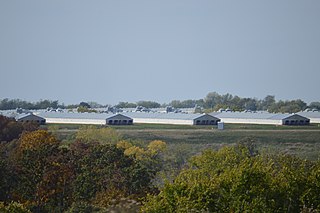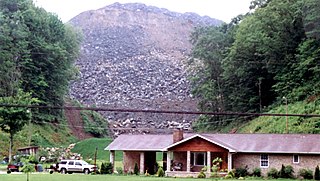
The Clean Water Act (CWA) is the primary federal law in the United States governing water pollution. Its objective is to restore and maintain the chemical, physical, and biological integrity of the nation's waters; recognizing the responsibilities of the states in addressing pollution and providing assistance to states to do so, including funding for publicly owned treatment works for the improvement of wastewater treatment; and maintaining the integrity of wetlands.

In animal husbandry, a concentrated animal feeding operation, as defined by the United States Department of Agriculture (USDA), is an intensive animal feeding operation (AFO) in which over 1,000 animal units are confined for over 45 days a year. An animal unit is the equivalent of 1,000 pounds of "live" animal weight. A thousand animal units equates to 700 dairy cows, 1,000 meat cows, 2,500 pigs weighing more than 55 pounds (25 kg), 10,000 pigs weighing under 55 pounds, 10,000 sheep, 55,000 turkeys, 125,000 chickens, or 82,000 egg laying hens or pullets.

Mountaintop removal mining (MTR), also known as mountaintop mining (MTM), is a form of surface mining at the summit or summit ridge of a mountain. Coal seams are extracted from a mountain by removing the land, or overburden, above the seams. This process is considered to be safer compared to underground mining because the coal seams are accessed from above instead of underground. In the United States, this method of coal mining is conducted in the Appalachian Mountains in the eastern United States. Explosives are used to remove up to 400 vertical feet of mountain to expose underlying coal seams. Excess rock and soil is dumped into nearby valleys, in what are called "holler fills" or "valley fills".

Surface mining, including strip mining, open-pit mining and mountaintop removal mining, is a broad category of mining in which soil and rock overlying the mineral deposit are removed, in contrast to underground mining, in which the overlying rock is left in place, and the mineral is removed through shafts or tunnels.

Kentuckians for the Commonwealth (KFTC) is a grassroots community organization under the original name of the Kentuckian Fair Tax Coalition. It began when 26 people from 12 countries met in Hazard on August 17, 1981. Though statewide, KFTC has deep roots in eastern Kentucky where coal mining remains the dominant industry. KFTC is a multi-issue organization of working-class families, with a history of working for land reform, environmental justice, and low income assistance programs. In the 1980s, KFTC was part of a campaign to end strip mining using the broad form deed and has since continued to provide support to the Appalachian region. Joe Szakos was one of the founding organizers.

Massey Energy Company was a coal extractor in the United States with substantial operations in West Virginia, Kentucky and Virginia. By revenue, it was the fourth largest producer of coal in the United States and the largest coal producer in Central Appalachia. By coal production weight, it was the sixth largest producer of coal in the United States.
In the United States, a citizen suit is a lawsuit by a private citizen to enforce a statute. Citizen suits are particularly common in the field of environmental law.
International Coal Group, Inc. (ICG), is a company headquartered in Teays Valley, West Virginia that was incorporated in May 2004 by WL Ross & Co for the sole purpose of acquiring certain assets of Horizon. ICG eventually operated 12 mining complexes in Northern and Central Appalachia and one complex in the Illinois Basin. In November 2005, ICG had a stock offering on the New York Stock Exchange. In 2011 ICG became a subsidiary of Arch Coal, Inc in 2011.

Appalachian Voices is an American environmental organization. Their stated environmental concerns include eliminating air pollution, ending mountaintop removal, cleaning up coal ash pollution and promoting renewable energy and energy efficiency.
The Clean Water Protection Act was a bill introduced in the 111th United States Congress via the House of Representatives Subcommittee on Water Resources and Environment, of the Committee on Transportation and Infrastructure. It proposed to redefine "fill material" to not include mining "waste" under the Federal Water Pollution Control Act.
Arch Resources, previously known as Arch Coal, is an American coal mining and processing company. The company mines, processes, and markets bituminous and sub-bituminous coal with low sulfur content in the United States. Arch Resources is the second-largest supplier of coal in the United States, behind Peabody Energy. As of 2011 the company supplied 15% of the domestic market. Demand comes mainly from generators of electricity.
Coeur Alaska, Inc. v. Southeast Alaska Conservation Council, 557 U.S. 261 (2009), is a United States Supreme Court case that was decided in favor of Coeur Alaska's permit to dump mine waste in a lake. The case addressed tailings from the Kensington mine, an underground mine located in Alaska. The gold mine had not operated since 1928, and Coeur Alaska obtained a permit in 2005 from the United States Army Corps of Engineers (USACE) to dispose of up to 4.5 million tons of tailings in Lower Slate Lake, which is located in a National Forest.
North Mara Gold Mine is a combined open pit and underground gold mine in the Tarime District of the Mara Region of Tanzania. It is one of three gold mines of Acacia Mining plc, a company listed on the London Stock Exchange, that operates in Tanzania, the other two being Bulyanhulu and the Buzwagi Gold Mine.

Nonpoint source (NPS) water pollution regulations are environmental regulations that restrict or limit water pollution from diffuse or nonpoint effluent sources such as polluted runoff from agricultural areas in a river catchments or wind-borne debris blowing out to sea. In the United States, governments have taken a number of legal and regulatory approaches to controlling NPS effluent. Nonpoint water pollution sources include, for example, leakage from underground storage tanks, storm water runoff, atmospheric deposition of contaminants, and golf course, agricultural, and forestry runoff.

Point source water pollution comes from discrete conveyances and alters the chemical, biological, and physical characteristics of water. In the United States, it is largely regulated by the Clean Water Act (CWA). Among other things, the Act requires dischargers to obtain a National Pollutant Discharge Elimination System (NPDES) permit to legally discharge pollutants into a water body. However, point source pollution remains an issue in some water bodies, due to some limitations of the Act. Consequently, other regulatory approaches have emerged, such as water quality trading and voluntary community-level efforts.

The Clean Water Rule is a 2015 regulation published by the U.S. Environmental Protection Agency (EPA) and the United States Army Corps of Engineers (USACE) to clarify water resource management in the United States under a provision of the Clean Water Act of 1972. The regulation defined the scope of federal water protection in a more consistent manner, particularly over streams and wetlands which have a significant hydrological and ecological connection to traditional navigable waters, interstate waters, and territorial seas. It is also referred to as the Waters of the United States (WOTUS) rule, which defines all bodies of water that fall under U.S. federal jurisdiction. The rule was published in response to concerns about lack of clarity over the act's scope from legislators at multiple levels, industry members, researchers and other science professionals, activists, and citizens.

Environmental justice and coal mining in Appalachia is the study of environmental justice – the interdisciplinary body of social science literature studying theories of the environment and justice; environmental laws, policies, and their implementations and enforcement; development and sustainability; and political ecology – in relation to coal mining in Appalachia.

Environmental issues in Appalachia, a cultural region in the Eastern United States, include long term and ongoing environmental impact from human activity, and specific incidents of environmental harm such as environmental disasters related to mining. A mountainous area with significant coal deposits, many environmental issues in the region are related to coal and gas extraction. Some extraction practices, particularly surface mining, have met significant resistance locally and at times have received international attention.
As a legal document, the broad form deed severs a property into surface and mineral rights. This allows other individuals or organizations other than the land owners to purchase rights to resources below the surface. These parties also receive use of surface resources — such as wood or water — to facilitate gathering the resources below ground. Based on English legal theory but an American creation from the early 1900s, the broad form deed was used by land and coal companies in many states within the Appalachian Region.
The Martin County water crisis is an on-going public health crisis that began in 2000, when a coal slurry spill contaminated the area's water supply with cancer-causing disinfection byproducts and coliform bacteria. Residents report the water having a strong smell of chlorine, discoloration, odd taste, sediment and irritation/burning when in contact with skin. The contamination was caused by the spillage of approximately 300 million gallons of arsenic and mercury concentrated coal sludge into an abandoned underground mine and two tributaries of the Tug Fork River by local coal company Massey Energy Company on October 11, 2000. According to the Environmental Protection Agency (EPA), the spill was one of the worst environmental disasters ever in the southern United States.











